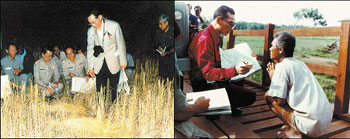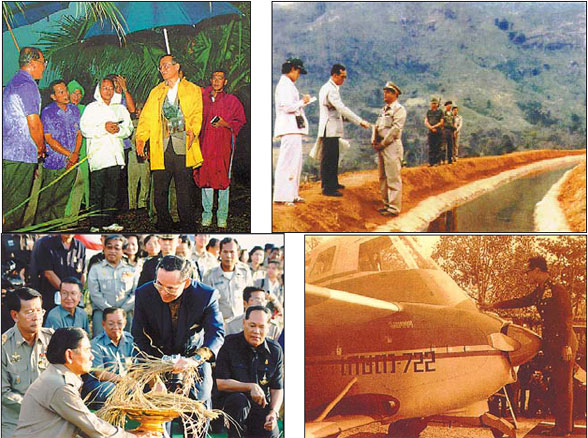The working monarch
Since 1946, His Majesty King Bhumibol Adulyadej of Thailand has initiated development projects on a comprehensive scale with the main purpose of improving Thais' quality of life. To date, these projects have been improving and expanding, delivering tangible and sustainable benefits to people across Thailand.
Thailand is an agrarian-based country. Recognizing the importance of soil, water, forest and human developments, all Royal development projects initiated by His Majesty are based on these simple concepts that people can put into practice. To date, His Majesty has inspired more than 3,000 royal development projects.
Rainmaking

Among the best-known and most successful of His Majesty's water provision projects has been the Royal Rainmaking program. After visiting the United States in 1962, he began to study how clouds might be seeded to produce rain.
Initially, he financed the research with his own funds. Then in 1970, he sought temporary funding for a "Rainmaking Project" from the government. With it, he established the Royal Rainmaking Research and Development Institute. Based on it, he has spent succeeding years refining his techniques to accord with varying cloud conditions and to suit differing climatological and geographic areas, enjoying considerable success throughout Thailand.
He continues to investigate new techniques. In 1999, he devised what he called the "Super Sandwich." After agitating and fattening the clouds, two aircraft are sent aloft, one to seed dry ice in the warm sections of the cloud base, the other to seed the cooler cloud mass at 3,000 meters elevation.
Rain invariably falls on the parched land.
The Royal Rainmaking Project was registered with the World Meteorological Organization in 1982 and today shares research data with similar bodies around the world.
In 1999, he created a pictorial "Royal Rainmaking Textbook" to guide others pursuing the technology. In 2001, he was awarded the Gold Medal with Mention at Brussels Eureka 2001 for this book and for the project itself.
Irrigation

In the 1950's, the northeastern part of Thailand lacked piped water and household electricity. Thus, the goal was to build dams for hydroelectric power and irrigation, a task to which he would devote his energies over the next two decades.
The largest, Sirindhorn Dam, built in 1971, created an enormous lake between Ubon Ratchathani and the border with Laos. It was able to supply a wide area with irrigation water and fish from its stocked waters to supplement family incomes.
His Majesty then turned his attention to other areas of Thailand. His interest was not only in impounding water for irrigation but in preserving watershed areas to ensure a year-round supply. Of particular interest were small village ponds for irrigation and a habitat for fish. He has been tireless in working with villagers to realize their dreams of a constant water supply.

(China Daily 12/05/2007 page21)














